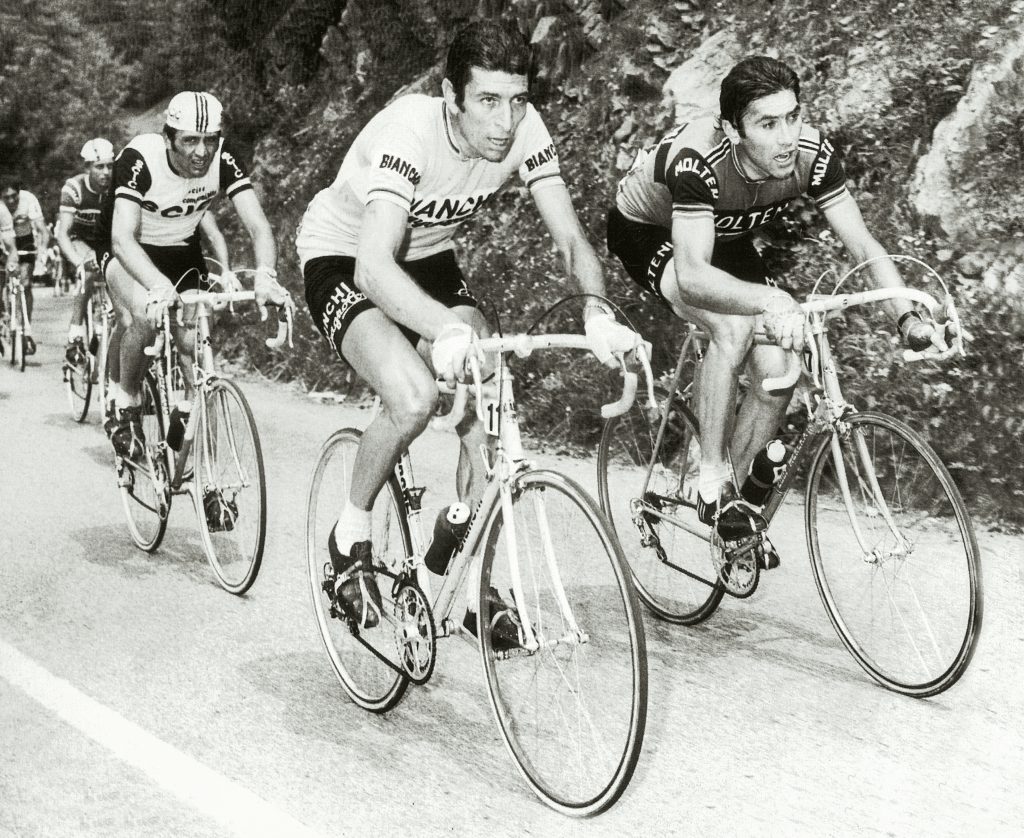Photo: Gimondi – Merckx – Baronchelli
There’s just something about Italians: they have style that few other countries can match. How they do it is a bit of a mystery as they have had sixty-one governments since 1945, and are hardly a by-word for order and, shall we say, civic competence. Yet they produce some of the most iconic examples of fashion and style anywhere as well as some of the most beautiful races on the calendar: Milan-San Remo, the Giro d”Italia and the Giro di Lombardia. Go figure.
Italy also produces some remarkable cyclists who are, strangely enough, as stylish as they are successful. To wit: Felice Gimondi, who tragically passed away the other week while swimming. Gimondi was only the second cyclist (after the Frenchman Jacques Anquetil) to win all three grand tours. He was world road race champion (1973), and also won Paris-Roubaix (1966) at a time when few Italians ventured north of the Dolomites to race. His pro career was a long one – 14 years on only two teams: Salvarani (1965-72) and Bianchi (1973-79). Compared to today’s team-hopping riders, that’s amazing consistency and loyalty.
His palmares are incredible, 143 amateur and professional wins, 56 seconds, 38 third place. His first, and only, Tour win was in 1965 at the precocious age of 22 as a neo-pro. His immediate success was a blessing as between 1965 and 1969 he won the Tour, Paris-Roubaix, Giro di Lombardia (1966), the Giro d’Italia (1967 and 69), the Grand Prix des Nations (1967 and 68), and the Vuelta (1968). This remarkable run of success was dampened somewhat by the arrival in 1969 of a young Belgian called Eddy Merckx who soon earned the nickname “the Cannibal” for his insatiable appetite for winning. Merckx “dampened” a lot of careers, but Gimondi remained in the top echelon winning the Tour of Romandie (1969 and 71), Volta a Catalunya ((1972), World Road Championship, Giro del Piemonte, Giro di Lombardia, Trofeo Baracchi, Coppa Bernocchi, Giro di Puglia (1973), Milan San Remo (1974) and a final Giro in 1976.
In summation, he won five grand tours, four Monuments plus some other major wins such as the Trofeo Baracchi which was the unofficial two-up Time trial championship.
Gimondi was a pivotal figure in Italian cycling. The days of Fausto Coppi , Gino Bartali and Fiorenzo Magni were over and the bitter rivalry of Moser and Saronni yet to begin. Gastone Nencini had won the Tour in 1961 but then came Anquetil’s four-in-a-row. Gimondi’s 1965 win was the last Italian victory until Marco Pantani’s in 1998. Riders like Gianni Motta and Marino Basso showed promise but never fully rose to the top. From 1950 with Coppi’s win until 1978 and the first of Francesco Moser’s three wins, the only Italian to win Paris-Roubaix was Gimondi. He arguably kept Italian cycling alive during those years of Merckx’s domination. I’m not overestimating things: such was Merckx’s dominance plus other foreigners winning the Giro in the early 70s, Italian broadcaster RAI stopped covering the race live. No TV? No sponsors. No teams. Things were bad and Gimoindi arguably proved one of the few consistent bright sparks on the scene.
As successful as he was, another defining attribute of the man from Bergamo was his tenacity. Ask any rider whose peak career years coincided with those of Merckx and each one would say that had it not been for the extra-terrestrial Belgian, their palmares would have been much more illustrious. Gimondi fought Merckx tooth-and-nail in so many races and sometimes won: for example the 1973 World Championship where he beat Freddy Maertens, Luis Ocana and Merckx – on the brutal Monjuich circuit in Barcelona.
But back to style. Gimondi was blessed to have worn some of the greatest jerseys ever: the Salvarani pale blue, the World Championship’s rainbow bands, the Maillot Jaune, the Maglia Rosa, the Italian road champion’s tricolore and the classic celeste Bianchi. These were all coupled with black shorts, short white socks and black leather shoes and made for unassailable cycling sartorialism. He even had the audacity to age spectacularly well, keeping a fine head of hair, his figure trim and dressed in that casual style to which Italian men know the secrets. No wonder one of his nicknames was “The Aristocrat” – he had that demeanor to him.
With the passing of Gimondi, cycling has lost another legend. Patrick Sercu, a contemporary of the Italian’s, passed away earlier this year. The great riders of the 60s and 70s are leaving us physically, but leaving behind accomplishments and successes that still thrill. Just watch Stars and Watercarriers, Jorgen Leth’s masterful film of the 1973 Giro. Arguably the best cycling film ever made and Gimondi is right in there, finishing second to an imperious Merckx.
How beloved was Gimondi? Over 2000 people attended his funeral which was broadcast on television. Of all the tributes that poured in about a rider who seems to have been universally beloved, it was the one from his arch rival, nemesis and friend Eddy Merckx that expressed the most sorrow. “What can I say, I am destroyed,” Merckx said. “Felice was first of all a great man, a great champion, and unfortunately, they took him away. It’s a big loss for cycling. All the struggles we have done together come to mind… A man like Gimondi is not born every day, with him goes a slice of my life. He was among the greatest ever.” Merckx did not attend the funeral, so deep was his grief.
There are few left that Merckx will mourn in such a way.


Felice Gimondi was the definition of both style and class. And +1 for “Stars and Watercarriers.” My wife just rolls her eyes whenever I watch the DVD. Even though I wasn’t a cyclist at the time (I was a tennis player as a junior), it evokes my youth and a summer I spent in France going to school and living with a French family in Dinan.
The comment made by Merckx below brought a lump to my throat.
“This time I lose,” Merckx told ANSA news agency when hearing the news.
“First of all, I lose a friend and then the opponent of a lifetime. We competed for years on the road against each other, but we became friends at the end of our career. I had last spoken with him two weeks ago, as we did every now and then.”